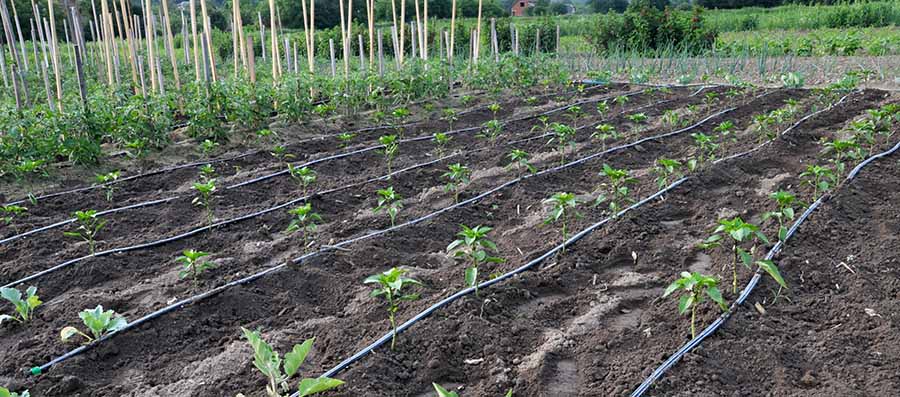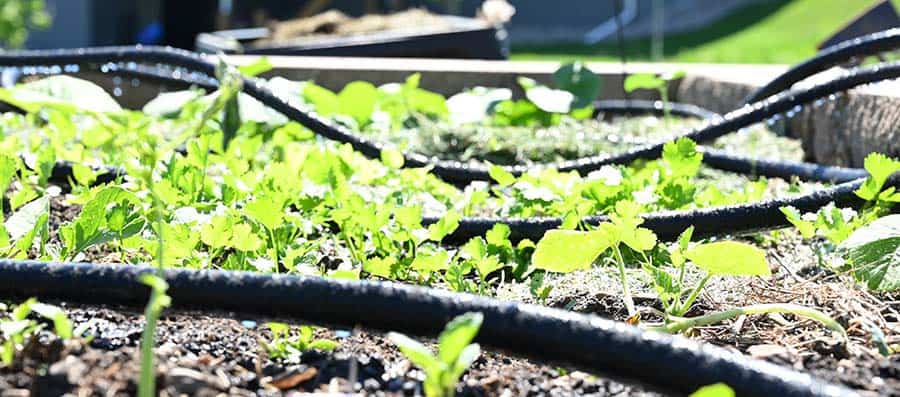Drip irrigation tubing ensures that all the plants in the field get an equal amount of water with the least possible evaporation. You must have noticed that most of the farms have that tubing on the ground, and it isn’t buried. This article is all about irrigation tubing and whether it can be buried or not.
It is possible to bury the irrigation tubes under the ground but it’s not recommended. The irrigation tube will squeeze due to the soil’s weight, which will cut off the water flow or even damage the system. Besides that, soil can clog the system and will reduce the lifespan drastically.
If you’re looking for drip irrigation information, make sure to read the article until the end.
How Long Can A Drip Irrigation Line Be?
The length of the irrigation tube is dependent on its width and the water pressure. The irrigation tube’s length and width need to be in a proper proportion for the best results. The improper ratio of the length and width will disturb physics laws, and the expected output will be diminished.
Keep in mind that pressure plays as much of a role as do the length and diameter. However, too much pressure and fittings will simply blow out of the line.

Standard Width Of Drip Irrigation Tube
- The standard width of an irrigation tubing is ½ inch. But nowadays, the market is flourishing with a lot of varieties (check them out here on Amazon). Based on that, the length changes dramatically.
- Other than the standard ½ inch tube, many people consider using a ¼ inch tube, which is commonly known as the spaghetti tubing. But the maintenance is a headache, so you may want to consider the larger standard size.
Standard Length Of A Tube
- If you’re using a standard ½ inch wide tube for drip irrigation purposes, then the length can go up to 2000 linear feet. This size can handle a maximum flow of 240 GPH or 4 GPM.
- A ¼ inch wide drip irrigation tube must not be any longer than 19 feet. This size can handle a maximum flow of 30 GPH or 0.5 GPM.
So based on your requirements, you can now choose the best size and length all on your own. You must never install large capacity tubes, which might be left underutilized because that’ll affect the tube’s water pressure.
What Is The Best Drip Irrigation Tubing?
If you’re looking to set up drip irrigation, most probably on your farm or a vineyard, then you must be worried about the best tubing. There’s a vast range of products out there on the market, and it’s natural to wonder which is best. If you’re concerned about the quality, then follow this section.
Some of the best drip irrigation tubings are made of polyethylene. This material is considered to be the backbone of a drip irrigation system. Tubing which is made of polyethylene is durable, which ensures the long lifespan of the irrigation system in the field.
Previously, the width of the tube was mentioned. Based on that, here’s a small list of some best tubes for a drip irrigation system.
● ¼ Inch Soaker Dripline
This tube is widely used in garden beds, planter boxes, etc. You’ll get emitters pre-installed in the tube at every 6,9 or maybe 12 inches, depending on what the shopkeeper has got in the stock. Thanks to its flexibility, you can fold it as you wish. On Amazon, you can get driplines made in the USA, check them out here.
● ½ Inch Emitter Tube
Under the ½ inch category, this tube is perfect for long rows on hilly and flat terrain. The most common applications include orchards, vineyards, etc. Again, you’ll get emitters installed at every 9, 12, 18, or 24 inches.
● Oval Hose
As the name suggests, you can coil this tube up neatly. If you’re looking for low-pressure irrigation, then the oval hose is the best.
● IPS Tubing
This tube is the strongest of all. Such lines are widely used in vineyards, where the underground water tank has to be connected to grapes’ rows. Unfortunately, this tube isn’t suitable to be used at constant pressure.
If you like to know how you can Make a Cheap Drip Irrigation System (Under $ 200), check out this article here.
How Do You Make A Hole In A Drip Irrigation Tubing?
Even though the irrigation tubes typically have pre-installed emitters, you might end up installing some by yourself. If that happens, you’ll need to make a hole in the tube. It’s easier said than done. So, this section will tell you all about making holes in the tube.
Holes in the drip irrigation tubes can be made with the help of a sharp and hot needle. Piercing the needle in the tube will create holes. However, it is essential to make all the holes of equal size; otherwise, the emitters won’t fit perfectly in the line.
Merely making holes this way won’t work. After you’re done with the piercing part, the next step is to install the barbed drip emitters in them. They’re small devices, made up of plastic.
The emitter controls how much water comes out from each hole. Of course, you wouldn’t want some parts of your field to be all muddy, while some parts remain dry. Simply snap the barbs into the punched holes.
Of course there are other components one could get to install into the tube like splitters or adapters to run a ¼” line off the main line. Take a look at your options and make the most efficient system you can for your gardens.
Which Is Better: Soaker Hose Or Drip Irrigation?

Other than drip irrigation, a soaker hose is yet another famous technique to water gardens.
Both soaker hose and drip irrigation are great watering techniques. Based on the application and requirements, either of the two methods is implemented. So what are those factors which can affect where we apply them? Let’s take a look.
Why Is Soaker Hose Better?
- A soaker hose is best when looking to set up an irrigation system in a small area. Consider your garden. There’s no way you can compare it with a farm in terms of size. So, use a soaker hose at small places for best results.
- It’s a cheaper method than the other one. Why waste money when there’s a cheaper way out?
Take a look at this drip installation video from YouTube:
Why Is Drip Irrigation Better?
- Even though a drip irrigation system can cost you a fortune, it’s worth every penny.
- Drip irrigation isn’t great for small areas. When you want to cover a large plot, such as farms, vineyards, etc., this is the only suggested method.
Why Is Drip Irrigation Good?
Drip irrigation is considered among the top methods when planting crops and plants on a large scale. But then, here comes a question of why is this method suitable? So, this section is all about clearing the mystery behind this form of irrigation.
Drip irrigation system targets on sending the water directly to the roots of the plants. This process severely limits the evaporation process. As a result, less water is required due to reduced evaporation.
Here is the summary of key points why drip irrigation is good:
- Low evaporation rate: since the water has a short path to the plant roots, less water evaporates.
- Drip irrigation works on low pressure. You won’t require much electrical energy to power up those water pumps.
- A drip irrigation system does not require too many human resources. If you were to water large fields, one way to achieve that is to hire people who water the fields. That’d be very expensive. So a drip irrigation system can help you save a lot of money.
- It’ll help you sprinkle the water all over the field in an equal amount.
- You can attach emitters and sprinklers in the drip irrigation tubing to direct the water in a way that sprinkler systems simply cannot achieve.
Conclusion
Drip irrigation is one of the most popular irrigation systems in the entire world. The endless benefits make this method no less than revolutionary in the irrigation domain. If you’re looking for an extensive scale coverage, then drip irrigation is a perfect choice.
The easy setup feature further enhances its popularity. So if you’re looking to water your garden, a vineyard, or a farm, always remember that a drip irrigation system will let you accomplish your watering goals. Till now, no other system has been able to beat the drip irrigation system, so its supremacy still goes on!

